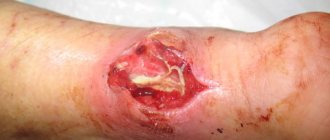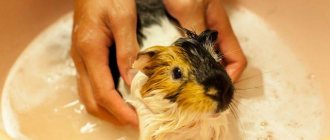Guinea pigs are a type of domesticated rodent, the first mention of which is found in the ancient writings of the peoples of South America. At different times, these animals were kept for sacrificial rituals, creation of works of art, use in agriculture (as food for large predators) and even consumption directly as a source of essential amino acids and protein. Currently, guinea pigs are kept as pets, since almost all breeds have a friendly character, do not require special care and maintenance, and some of them can be successfully trained. Allergies to guinea pigs are rare, but such cases are still recorded annually, so before purchasing an animal it is better to make sure that there are no immunopathological reactions.
Allergy prevention methods
Preventive measures do not provide a 100% guarantee of recovery.
Only avoiding contact with the animal will allow you to completely get rid of the problem. It is important to consider that not only the guinea pig, but also the bedding (hay) can be a strong allergen. It is recommended to separately test the option used and, if positive results are obtained, change it to other types (absorbent diapers, mats or sawdust)
Prevention methods without getting rid of your pet:
- place the cage or container in a separate room (not in the bedroom or nursery);
- Caring for animals should be done with protective gloves;
- do not bring the mumps close to your face (this way there will be no contact with the skin, particles of the irritant will not enter the body through inhalation);
- After contact (stroking, scratching) or cleaning the cage (wet or dry), you should thoroughly wash your hands with soap and warm water.
In cases where the allergy manifests itself with severe symptoms, you will additionally need:
- use a mask (during cleaning or contact with the animal);
- use an air filter to further purify the air in the room;
- use a humidifier (the concentration of the allergen decreases). You can use a simple device without additional functions, an ordinary pillowcase or sheet soaked in water. The main task is to prevent the allergen from being in the air.
- wash the guinea pig or wipe it with a damp cloth.
To get rid of a negative reaction to hay, you need to choose a different type of bedding or use fresh (exclude dusty or brown). When contacting or being in the same room with an animal, it is recommended to protect your hands (wear long sleeves). Additional methods of preventive action are a daily change of clothes. Also, you should not place your pet on a bed or upholstered furniture. Walking outside, taking vitamins and decoctions of herbs and plants will strengthen the body. Methods of prevention must be agreed upon with a doctor so as not to cause additional harm to health.
Symptoms and reactions will help determine if you have a guinea pig allergy. Recovery should begin with a full diagnosis. Treatment is always complex. The duration of therapy is determined by the person’s condition at the time of seeking help.
The first thing to remember: you need to wear long sleeves, especially before contact with the animal. Unfortunately, there is no universal method of combating and preventing the scourge. If the symptoms are severe, doctors advise getting rid of the pet, for example, by giving it to friends or relatives with less allergies. But there are universal tips for preventing the disease, namely:
- You should not keep the cage in the bedroom, especially next to the bed. An allergen in the air can cause even greater damage to a sleeping body. In addition, animals often make noise at night.
- Limit direct contact if there are concerns. For example, some people wear gloves.
- If you have allergies, you can trust someone else to clean the cage. For example, for a child, if he has no problems: this will teach the child to take care of animals.
- If you have any pet, it would be a good idea to have an air purifier, which is best placed near the cage.
An allergy can occur not only to the pet, but also to the litter or food. In this case, you should look for an alternative by consulting with a specialist.
When thinking about yourself, it is important not to forget about the condition of the animal
Experts advise that in case of particularly strong reactions, provide special clothing for contact and play with the animal. Which should be kept separate from the usual one and washed regularly. Don't forget to wash your hands every time after touching your pet.
It is worth taking care of the coat in a timely manner, as well as familiarizing yourself with the possibility of water treatments, haircuts and other activities. After all, wool is often the main allergen.
Despite such difficulties, guinea pigs are considered full-fledged pets and family members. Before buying an animal, you just need to show responsibility and go through the proper procedures, as well as familiarize household members with the responsibilities and measures to prevent the disease.
Pets without hair
Despite the small number of hairless animals, their species range is quite diverse.
Reptiles top the list: fish, turtles, lizards, chameleons, snakes.
IMPORTANT: It must be remembered that all these cold-blooded animals require special housing conditions, careful care and adherence to a diet. If you decide to make such a little friend for your baby, read in advance the information regarding all the pros and cons of such a choice.
Turtles can act as carriers of one of the intestinal infections - salmonellosis. Therefore, even after short-term contact with such a pet, you must wash your hands very thoroughly.
No less popular, despite the terrible high cost, are hairless cats of the Sphynx and Elf breeds. To prevent the skin oils of these hairless cuties from causing allergies, they need to be bathed frequently, which, by the way, they love very much.
Aquarium fish - pets without hair
Scientists also made some guinea pigs bald, creating the Skinny and Baldwin breeds. Caring for such pets is no different from caring for their furry brothers.
There are also several breeds of hairless dogs:
- In first place in popularity is an animal with a very exotic appearance - the Chinese Crested. She can be classified as a combi breed, since her head is crowned with a chic bang, followed by a long mane, the ends of her paws are decorated with luxurious cuffs and she will not be ashamed of the hair on her tail
- The Mexican Hairless Dog or Xoloitzcuintle is completely hairless. This breed comes in two varieties: hairless and coated, and both types can be in the same litter
- Another hairless dog is the Peruvian Hairless Dog, also called the Peruvian Orchid for its charming tuft on its head.
There are also hairless rats, which are very cute and defenseless in appearance, unlike their furry counterparts. Despite the presence of several breeds in nature - Dumbo, Manx - they are all usually called, like cats, Sphynxes.
Hypoallergenic Sphynx rat
Is it possible to leave a pet if the allergy is not severe?
What to do when a guinea pig has already become a family favorite, and it becomes clear that it is a source of allergen for a child or an adult?
First you need to find out what exactly you are allergic to. If it is a certain type of food, replacing it will solve the problem. When it's all about the fungal antigen, frequent cleaning of the cage will eliminate the source of irritation. If allergic manifestations are not severe, you can try not to give the animal “in good hands” yet, but take preventive measures.
Preventive measures against allergies depend on the living conditions of the animal and include the following measures:
- Before cleaning the cage, wear latex gloves;
- change the dirty bedding in your pet’s cage at least once a day;
- carry out wet cleaning in the house as often as possible;
- regularly ventilate the room;
- if the child wants to “snuggle” the pig, put on gloves and a cotton-gauze bandage;
- place the cage away from the bedroom;
- do not allow the pig to dirty sofas and armchairs;
- install an air filter that purifies the air in the house.
If the house is large, it is enough to take the guinea pig to a distant room and entrust it to family members who do not have allergies to care for it.
If a child or adult has an allergy to mumps, this is a “bell” that indicates a problem in the immune system. You need to say “thank you” to an animal that makes you take care of your health.
Diagnosis of the disease
One of the main diagnostic methods is an allergy test, which is performed using a small scratch applied with a scarifier to the inside of the forearm. After this, the suspected allergen (previously diluted with distilled water) is applied to the scratch. Such a test can help identify the specific allergen that provokes an acute allergy attack.
Another way of diagnostic examination is to conduct a blood test to determine the amount of IgE specific antibodies. If the amount of IgE antibodies is elevated, the doctor can monitor the body's reaction to the epidermal and animal protein of the guinea pig. In testing, this substance is classified as an inhalation allergen E6.
Treatment
First of all, you need to seek help from a doctor who will examine your body and prescribe a course of treatment that is suitable for you. The initiative should also come from you, but try not to overdo it with self-medication:
Firstly, it is necessary to exclude any contact with the animal; unfortunately, you will have to say goodbye to it forever if you want to maintain your health. We can say that there are cases when the allergy was provoked not by the animal itself, but by its food or sawdust, in which case you should simply change them to other means. Secondly, you need to take drugs such as: “Suprastin”, “Tavegil”, “Promethazine”
It is very important to follow the instructions to avoid side effects or overdose. Thirdly, to alleviate your situation, you can use folk remedies. Take baths with chamomile or nettle infusions
If you have a stuffy or runny nose, rinse your nose at least five times a day with the herb; naturally, you should not be allergic to it.
When you cough, you can drink fennel tinctures, and also gargle with baking soda or herbs every hour during the day.
Wipe your skin with celandine tinctures once every two hours.
Treatment with traditional methods should take place in two courses: the first 5 days we are treated, we rest for two days, and again we treat for 5 days.
If improvements do not make themselves felt, continue the course of treatment with traditional methods + use medications prescribed by your doctor.
Method of use of the drug "Promethazine"
- Take orally after meals.
- Adults: three times. During the day: 12-25 mg. At night: 25-50 mg.
- Children from 2 to 6 years: 12 mg 3 times a day.
- Children over 14 years of age: 25 mg 3 times a day.
Method of use of the drug "Tavegil"
- Take orally before meals.
- Adults and children over 12 years of age: one tablet morning and evening.
- Children from 6 to 12 years: half a tablet morning and evening.
Method of use of the drug "Zyrtec"
- For adults and children over 6 months.
- Adults and children over 7 years of age: 15 mg per day.
- Children from 2 to 6 years: 2.5 mg per day, twice a day.
- Children up to 2 years of age: 2.5 mg per day, twice a day.
- Children up to 6 months to one year: 2.5 mg per day, once a day.
Reasons for the body's negative response
The main reason for inadequate perception of certain substances by the immune system is a decrease in its functionality. The following can provoke the development of problems against the background of weak immunity:
- guinea pig fur;
- animal dander;
- sweating;
- saliva;
- excrement.
As soon as the allergen gets on the skin or inside the body, immune forces are activated. At the same time, the production of certain antibodies is enhanced, which fight the potentially dangerous substance. As a result, signs of allergic reactions appear. With the release of mucus and tears, the body is cleansed of the dangerous substance.
Guinea pigs cause allergies and this is a proven fact. Therefore, if an animal appears in the house, and after a certain period of time a person discovers problems in the body, immediately consult a doctor. Otherwise, the disease can lead to quite serious consequences. Addressing the problem at an early stage speeds up the healing process.
Is it possible to leave a pet if allergic manifestations are not severe?
Sometimes it happens that an animal has taken root in the family and brings only joy to everyone, but someone suddenly develops an allergy to its fur, saliva or dandruff. Most often it is not strong and the symptoms are a runny nose and nasal congestion.
In this case, the animal can be left in the house, but subject to several unconditional rules:
- mandatory daily cleaning of all rooms in the house;
- maintaining cleanliness and order in the cage;
- cleaning the cage strictly with gloves;
- after cleaning the cage, wash your hands thoroughly with soap and replace your clothes with clean ones;
- minimal contact of the sick family member with the animal. If a child with allergic reactions really wants to play with the pig, he needs to wear a gauze bandage. After handling the animal, wash your hands thoroughly;
- the pet’s home should not be in the room where an allergic person sleeps;
- do not allow your guinea pig to walk on upholstered furniture;
- It would be a good idea to purchase an air purifier to reduce the concentration of allergens in the air.
Allergy to guinea pigs
Guinea pigs are well-known and beloved rodents, domesticated more than two and a half thousand years ago. But not every person can afford to have this cute creature at home, even with all their love for it.
It would be more accurate to say that this is an allergy to wool (in most cases), saliva, “dandruff” (small flakes of skin that are constantly found between the hairs, even if the pet has just been bathed), and waste products of the animal.
The cause of the allergic reaction is the substance keratin, which is contained in wool. This substance of protein origin causes the active activity of class E immunoglobulins. This interaction of substances in the body provokes the release of histamines from cells, which provokes the external manifestation of allergies.
Symptoms, manifestations and diagnosis of allergies
Most often, people get pets without thinking about the fact that they may have allergies. Especially if there were no animals in the house before. In this case, the presence of an allergic reaction is determined, so to speak, “in combat conditions.”
Attention! The symptoms are very simple - runny nose, sneezing, inflammation of the mucous membranes, itching and redness of the skin. If this was not observed before the appearance of a guinea pig in the house, then it can be almost 100% stated that the cause of such increased sensitivity of the body was the pet. But there are also prudent people who first find out everything
To determine whether a person is allergic to a substance, they undergo a special allergy test. It identifies a substance that the body will perceive too sensitively: if redness appears on the area of skin on which the test was carried out after a quarter of an hour, this is a sign of an allergy
But there are also prudent people who find out everything first. To determine whether a person is allergic to a substance, they undergo a special allergy test. It identifies a substance that the body will perceive too sensitively: if redness appears on the area of the skin on which the test was carried out after a quarter of an hour, this is a sign of an allergy.
To identify allergies specifically to guinea pigs, you can also take a blood test to check for antibodies. But there is one easiest and free way to identify allergies. All you have to do is go to your friends who have a guinea pig, or to the pet store. It is enough that you hold the animal in your hands for a couple of minutes for the allergy, if any, to make itself felt.
Is it possible to cure allergies?
Often, treatment of allergic reactions to guinea pigs is reduced to symptomatic actions. But modern medicine has stepped far forward. This also applies to the treatment of allergies of any nature. For this, the patient is prescribed antihistamines - harmless substances that do not impair coordination, do not cause drowsiness or other side effects.
Enterosorbents are also used, which act like a sponge - they absorb substances that provoke allergic reactions, after which they are eliminated from the body naturally
It is very important that the treatment is limited in time, otherwise the body will get used to it and the drugs will stop working. And after the main course of treatment, the regimen must be changed.
But, despite the active use of such drugs, allergies cannot be completely cured; they can only be “healed.” This, however, in most cases is enough for a quiet life. The main thing is to minimize the factors that provoke it, strengthen the general condition of the body and immunity, since people who have chronic diseases and often suffer from colds are much more susceptible to allergies.
Allergy prevention
As sad as it may be, the most effective preventative measure is to remove the allergen from your environment. That is, if no medications help get rid of the allergy or it has become aggravated, the first thing to do is to find a new owner for your pet.
But this is the most extreme case. If the manifestations of an allergic reaction are not so significant, you can simply minimize direct contact with the animal - let it run around in another room, and the cage in which the guinea pig is at night and most of the day is in the kitchen or in another room. It is also recommended to regularly clean the air and disinfect the cage.
It is not the person who suffers from allergies who should care for the guinea pig, but if this is not possible, it is better to bathe and feed the pig while wearing gloves. After playing with an animal or feeding, you should definitely wash your hands with soap, and for those with severe allergies, it is recommended that you even change your clothes.
Answers on questions
If a child has allergies, is it possible to get a guinea pig?
Before getting an animal, you need to find out if there is an allergy to this particular animal and undergo the necessary tests. Only in this case will it be possible to avoid an allergic reaction and hassle about where to place the animal.
It is worth saying that guinea pigs are quite “hypoallergenic” animals. If you do not allow your child to touch them with his hands and bring them to his face, the likelihood of developing an allergy is not high.
My child is allergic to guinea pig bedding, what should I do?
The question is what kind of bedding the child is allergic to. There are several bedding options for guinea pigs.
- Sawdust. This may be a factory filler, or it may be sawdust prepared independently.
- PVC mat.
- Line with paper towels or napkins.
- Baby absorbent diaper.
- Fleece.
- Hay.
For example, if your child is allergic to sawdust or hay, it is enough to choose any other of the listed types of bedding. There is another good alternative to sawdust: wood pellets, which are sold in pet stores.
All these factors together constitute a single cause of guinea pig allergy. The risk of becoming allergic to a hairless animal is the same as to a “fluffy” animal. For this reason, it makes no sense to single out the “most hypoallergenic” breed of these animals.
This statement is especially true considering that the main allergen is found in wool, skin, and urine.
It is worth saying that the absence of fur is “advantageous” in the sense that it is more difficult to “earn” allergic rhinitis and conjunctivitis: if a child washes his hands thoroughly after touching an animal, then the risk of allergies decreases.
Can you buy guinea pigs if you are allergic to wool?
Before purchasing an animal, it is advisable to find out whether you are allergic to a guinea pig.
Many of us are pet lovers. Very often it’s even difficult to imagine your life without a cute animal that becomes a member of the family. Pets not only bring color to our lives, but also often cause trouble. For example, they can cause such a negative reaction of the human body as an allergy. This can be especially pronounced in young children, who are just beginning to develop their own immune system.
Guinea pigs are one of the few four-legged animals that are easy to care for and safe for children. Therefore, families who have small children often choose this type of pet. However, if any of the family members are prone to allergies, then the question will certainly arise - is there an allergy to guinea pigs? Unfortunately, it can be just like an allergy to cats, dogs and other animals, and then the question of whether to get a guinea pig becomes relevant.
Treatment of atopic dermatitis in children
There is no complete treatment for atopic dermatitis, that is, there are no methods of therapy that would lead to complete recovery (change the long-term prognosis of the disease). All existing methods of therapy change only the short-term prognosis - for the coming months.
However, treatment is necessary:
- to improve the quality of life of the child and family; for the prevention of secondary local complications (infections, skin atrophy, etc.);
- for the prevention of psychological problems (sleep disorders, depression, etc.).
Treatment is divided into lifestyle changes (eliminating triggers) and drug interventions (eliminating symptoms).
Change of life. What can parents do themselves?
Don't let your baby's skin become excessively dry, severe itching, and avoid triggers. Try following these simple tips:
- Children with atopic dermatitis should take short baths or shower with warm (not hot) water. Use mild, unscented soap or soap-free cleansers. Do not wipe, but pat your skin with a towel after washing. Immediately after bathing, apply moisturizer to your entire skin. Teenagers prefer to use unscented cosmetics and oil-free facial moisturizers.
- Consult your doctor; if your child has no contraindications, add oat decoction to the bath when bathing; it can reduce itching.
- Preference should be given to soft children's clothing made from breathable fabrics, such as cotton. Wool or polyester may be too harsh or irritating for atopic skin.
- Your child's nails should be trimmed regularly and short to prevent scratching of the skin. If your child scratches himself at night, try putting him to bed in comfortable, lightweight mittens or with the sleeves of his pajamas sewn up.
- Overheating of children should be avoided, as sweat can lead to exacerbations. This is especially true for Russian parents who are accustomed to hot temperatures in the apartment and wrapping their children up during walks.
- Children should be encouraged to drink plenty of water.
- Try to get rid of common allergens in and outside your home, such as pollen, mold and tobacco smoke.
- Stress can make atopic dermatitis worse. Help your child find ways to cope with stress (such as exercise, deep breathing, or talking to a counselor).
Is it possible to cure allergies and how?
Allergy treatment cannot be delayed. Symptoms may worsen and complications such as severe shortness of breath may occur. Unfortunately, if a certain allergen is present in the body, then you cannot get rid of it; you can only remove unpleasant symptoms. So what to do?
Allergies are treated with antihistamines. They are practically safe and have minimal side effects. These drugs are used both to relieve symptoms in adults and children. Unpleasant manifestations are eliminated in a fairly short time.
Xizal
The product quickly relieves symptoms of allergic urticaria and Quincke's edema. Children can take it from two years of age. The only contraindications are during pregnancy.
Zyrtec
It is convenient because it is available not only in tablets, but also in drops. Babies can start from six months. Cope with conjunctivitis, urticaria, anaphylactic shock, allergic cough and sneezing, runny nose, nasal congestion.
Elzet
Effectively and quickly copes with rhinitis and allergic edema. Accepted strictly from the age of six.
When using medications against allergy symptoms, one must take into account the child’s age and dosage.
Erius
Available in the form of syrup and tablets. This is convenient for using the drug in infants. There are no sedative manifestations.
Has a quick effect. Of the contraindications, only individual reactions to the body’s failure to accept certain components can be noted.
Telfast
When using the drug, the production of histamine is blocked. Can be taken from the age of twelve. Rarely, but there are side effects in the form of: migraines, drowsiness, gastrointestinal disorders.
Once the irritating factor is eliminated and the medications are administered, the allergy subsides. In rare cases, additional hormonal therapy may have to be used, along with creams and ointments, to eliminate skin lesions.
How to stop an attack?
For the symptomatic treatment of allergies, antihistamines that block the production of histamine are used: Suprastin, Tavegil, Cetirizine. Their effect begins within 15-30 minutes after administration and lasts for 24 hours.
For severe attacks, a treatment regimen is selected individually, which may include the following groups of drugs:
- mast cell cell membrane stabilizers with moderate H1-inhibitory activity (“Ketotifen”);
- sympathomimetics, adrenergic agonists (“Epinephrine”, “Adrenaline”);
- glucocorticosteroid hormones that have a pronounced anti-inflammatory effect (“Hydrocortisone”, “Cortisone”, “Prednisolone”);
- adenosinergic drugs (Theophylline, Ventax, Theostat);
- preparations of cromoglycic acid (calcium cromoglycate);
- enterosorbents (the effectiveness in the treatment of animal allergies has not been sufficiently studied).
To quickly relieve anaphylactic shock, you must always have a syringe with adrenaline with you.
What does guinea pig allergy prevention include?
Preventive measures will help alleviate exacerbation and allergy symptoms; they are recommended for all allergy sufferers.
- Limit time with animals, in this case guinea pigs. If such a pet is still present, it is not recommended to place the cage in the kitchen or bedroom.
- You will have to entrust the care of your pet to a person who does not have such allergies.
- The animal must be bathed regularly and its cage cleaned. To prevent particles of its vital activity from spreading through the air with dust, use air purifiers.
If you plan to buy a guinea pig, you can determine in advance whether there is an allergy. To do this, you need to go to the zoo or pet store and hold the animal in your hands. If one of your friends or acquaintances has a guinea pig, you can conduct an experiment on it. If after a short contact the first symptoms begin to appear, you should not get an animal.
No matter how much you would like to have such a pet, you should understand that an allergic reaction is a disease that negatively affects the body, and if it is possible to avoid the allergen, this should be done.
How to care for animals to minimize the likelihood of allergies?
It is best if your favorite pig is cared for by a family member who tolerates contact with the animal well. The first rule is to keep the cage and the pet itself clean. That is, wet cleaning and cleaning of the cage should be regular, if not daily. You should also bathe your animal more often, but here you need to understand how beneficial it is for him, and observe temperature conditions so that the pet does not get sick. Only the highest quality filler should be used. It is unlikely to cause a negative reaction in the body. The pet store will tell you what types of litter are suitable for guinea pigs. It is necessary to ventilate the room and clean the air in the apartment regularly so that harmful substances do not linger in the room for a long time.
Treatment
It is impossible to completely recover from guinea pig allergy, since it is a hereditary tendency of the body. But if you seek the help of a competent doctor, he will prescribe a course of treatment and preventive measures that will reduce the manifestations of allergies to a minimum.
Medication
Swelling of the airways requires serious attention to avoid suffocation, loss of consciousness and anaphylactic shock. Antihistamines are usually used for treatment
They should be used with caution due to side effects associated with weakness, increased stress on the heart, kidneys, and nervous system
Three generations of antihistamines have been developed, the latter having minimal negative effects on the body. In serious situations and during exacerbations and attacks, hormonal drugs - corticosteroids - are prescribed.
If an attack occurs, before the doctors arrive, the patient must be given a sedative (panic due to suffocation will worsen the situation) and placed in a safe position that does not allow the tongue to retract.
Allergic rhinitis is effectively treated with nasal sprays and drops during an exacerbation. Hygienic solutions for rinsing the nose can be used for prevention on a daily basis: regular cleansing of the respiratory tract reduces the manifestation of allergies. Antihistamines are required. Accumulating in the body, they stabilize the condition.
When fighting skin allergies, much attention is paid to local effects on the affected areas with ointments and compresses. But in order for the treatment to progress, they are used in combination with antihistamines
If an allergy causes conjunctivitis, basic antihistamine treatment should be combined with local symptomatic treatment - drops to correct the functioning of the lacrimal canals, anti-inflammatory lotions. The complex course of eye allergies is also corrected with corticosteroids and histamine blockers, but only under the supervision of a specialist.
Traditional methods
Traditional medicine offers allergy sufferers many ways to get rid of the disease.
Homemade recipes have their advantages and disadvantages. These drugs are safe, do not negatively affect other organs, are combined with basic medications and are suitable for prevention. But if the diagnosis is serious, there is a tendency to have seizures, then do not experiment. Self-medication with traditional methods is contraindicated for children and pregnant women. An allergist will prescribe suitable medications.
Herbal infusions are taken orally for any manifestations of allergies to animals.
Dry herbs are first steamed with boiling water, then brought to a boil and filtered. You need to be treated with decoctions for at least one and a half months, some can be taken for six months, the main thing is regularity. Burdock roots, medicinal chamomile, St. John's wort, yarrow, dandelion - these plants relieve allergy symptoms and strengthen the immune system.
For skin allergies, a herbal bath relieves itching and restores the epidermis. The best option is a course of baths with the addition of a series. It is necessary to prepare a decoction, strain and add to water at a comfortable temperature. The good thing about this method is that it will not harm even small children with sensitive skin. Lotions from the series will enhance the effect of baths and relieve inflammation.
Soothing ointments and creams are prepared based on decoctions of medicinal herbs. A decoction of one plant or a complex collection is prepared, filtered, added to Vaseline or lard and mixed thoroughly. The finished product is applied topically to allergy-affected areas
Eyes can be cured with herbal infusions used as drops. Aloe juice diluted with water in a ratio of 1:10 will get rid of pus. Honey diluted with water in a ratio of 2:1 will relieve inflammation. Use it as drops or lotion.
Manifestations of atopic dermatitis
Skin symptoms and location of lesions vary in children of different ages. Common symptoms are the appearance of red, dry, itchy patches on the skin that occur as a result of inflammation. There is always itching - from mild to unbearable, disrupting sleep and appetite. Frequent scratching may cause scratches (scratching), oozing (separation of serous exudate through tiny defects in the epidermis), crusting, or erosion due to secondary infection. Sometimes, if atopic skin lesions, lesions from chronic pruritus and secondary infections last for many weeks, areas of skin atrophy (scars, hypopigmentation/hyperpigmentation, thinning or thickening of the skin) may develop.
In infants, atopic dermatitis usually affects the face, scalp, arms and legs. In older children, as a rule, only the elbows, popliteal fossae and wrists are affected. In some children with severe disease, the entire body may be affected. Eczema causes severe itching, which can in turn lead to a number of secondary problems: sleep disturbances, weight loss, depression (in the child or in the adult who cares for him), etc.
Symptoms usually worsen in the autumn-winter period (this fact is usually associated with the inclusion of central heating and more severe external climatic conditions) and improve in the spring-summer period, as well as in seaside resorts (this is usually associated with the abundance of ultraviolet radiation and milder climatic influences on affected skin). Typically, the most severe course of the disease is observed in children aged 6–18 months (in winter, exacerbations are more frequent and severe, in summer - less frequent and milder), then from year to year, exacerbations become less frequent and milder. By school, most children recover or have symptoms that do not reduce their quality of life.
Allergy prevention
As sad as it may be, the most effective preventative measure is to remove the allergen from your environment. That is, if no medications help get rid of the allergy or it has become aggravated, the first thing to do is to find a new owner for your pet. But this is the most extreme case. If the manifestations of an allergic reaction are not so significant, you can simply minimize direct contact with the animal - let it run around in another room, and the cage in which the guinea pig is at night and most of the day is in the kitchen or in another room. It is also recommended to regularly clean the air and disinfect the cage. It is not the person who suffers from allergies who should care for the guinea pig, but if this is not possible, it is better to bathe and feed the pig while wearing gloves. After playing with an animal or feeding, you should definitely wash your hands with soap, and for those with severe allergies, it is recommended that you even change your clothes.
Select the section Allergic diseases Symptoms and manifestations of allergies Diagnosis of allergies Treatment of allergies Pregnant and lactating Children and allergies Hypoallergenic life Allergy calendar
An undesirable reaction can be caused by both direct and indirect contact with animals. Animal allergens are also found in house dust. In addition to fur, experts also identify other irritants: animal saliva, animal waste, and dander from the surface of the skin.
An allergic reaction can be caused not only by the animal itself, but also by its bedding. For example, hay.
There are many breeds of pigs (Sheltie, Rosette, Skinny and Baldwin and many others). In addition to decorative varieties, in some countries there are also meat varieties, so you should expect the possibility of an allergy to meat.
What allergens can be
Antigens that can cause a reaction in a person to the presence of a guinea pig in the house can be grouped into the following groups:
- Epidermal. This includes allergens that are closely related to the animal itself. This is his fur, excrement, urine, salivary secretions and even dandruff.
- Pollenaceae. This group of antigens is associated with pet food, primarily with pollen of various plants, mainly cereals and weeds.
- Fungal. Molds and yeasts grow in pig bedding and can cause severe allergies.
- Insect. Pets can attract ectoparasites: lice, ticks and fleas. Because of this misfortune, the mood and well-being can change not only in the pet, but also in the owner, who is allergic to blood-sucking insects.
In practice, there have been situations when a child who cares for domestic animals developed a rare form of allergy, the cause of which was the child’s moral and biological reaction. It is observed in impressionable people, who, from excitement and fear for the life of the pet, can become covered with spots and sores, and suffer from shortness of breath.
The presence of allergens in a guinea pig does not mean that they will necessarily cause a reaction. The likelihood of an allergy in a baby increases if mom or dad has one. At risk are pregnant women, children under 3 years of age, and people whose immunity is weakened after suffering serious illnesses.
Interestingly, allergic reactions are not the prerogative of humans. Allergies in guinea pigs to some type of food or strong odors are not uncommon.
Symptoms of an allergy to an animal
The uniqueness of the problem is that allergies manifest themselves in each owner differently, individually. Some people experience skin rashes, others have sore eyes. A common symptom is an allergic cough. If one of the above signs manifests itself after contact with an animal, then in 80% of cases there is an allergy. If we interpret the disease in medical terms, the symptoms are as follows:
- Allergic rhinitis: stuffy nose, itchy nose, runny nose, frequent sneezing.
- Allergic conjunctivitis: eye redness, swelling, itching, excessive lacrimation.
- Skin problems (dermatitis): urticaria, itching, flaking, as well as characteristic rashes in some cases.
- Asthma: dry cough, characteristic wheezing, difficulty breathing, shortness of breath, which has not previously manifested itself.
Allergists identify the following symptoms:
- rhinitis;
- conjunctivitis (non-contagious form to others);
- dermatitis;
- asthma;
- hives.
Signs of the development of the disease appear according to an individual program. It depends on:
- stimulus concentration;
- its presence in the air (additional contact);
- individual characteristics of the body;
- state of the immune system;
- age of the person (newborn, teenager or adult).
Additional symptoms include:
- cough (the intensity and frequency of attacks varies);
- redness of the skin at the site of contact;
- peeling;
- itching;
- presence of edema;
- lacrimation;
- redness of the eyes.
Various combinations of manifestations are recorded in 90% of patients. Seeing a doctor for diagnosis and treatment is a mandatory step.
Allergic rhinitis
Allergic rhinitis (runny nose) manifests itself in the form of frequent sneezing and stuffiness. Body temperature can rise to 37-38 degrees. The flow of mucus from the nasal sinuses is of medium intensity, the secreted substance is transparent without inclusions.
Allergic conjunctivitis
The symptom appears 30-60 minutes after contact with the irritant. Characteristic features:
- redness of the eyes (skin of the eyelids, mucous membranes);
- itching;
- profuse lacrimation;
- light-colored discharge from the conjunctiva;
- inflammatory process.
Duration – 5-7 days. It is recommended to limit contact with your guinea pig.
Dermatitis
The problem occurs immediately after contact with the irritant. The skin suffers. Manifestations:
- peeling (the degree of severity varies individually);
- itching (scratching is not recommended to avoid damaging the skin);
- inflammation;
- dryness.
Additionally, cracking may occur. Duration – about 1 week.
Bronchial asthma
The problem manifests itself with the following symptoms:
- dry cough (with attacks);
- pronounced wheezing;
- difficulty breathing (danger of sudden suffocation without immediate help);
- dyspnea.
It is necessary to immediately limit contact with the irritant. Take medicine or call a doctor. During treatment, constant medical supervision is required.











